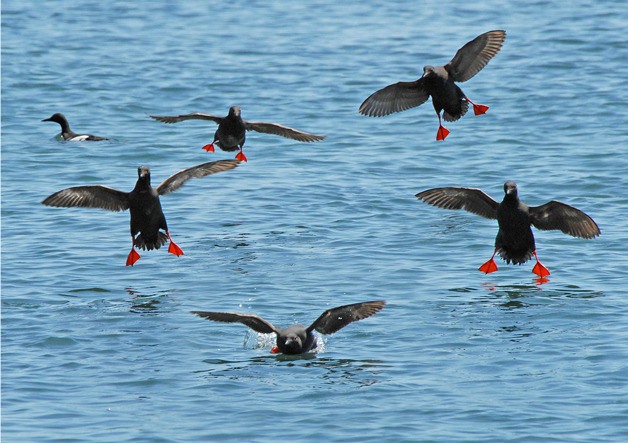Summer time and the living is easy, well at least for us humans. It’s the most demanding month for our avian friends. Eggs have hatched, babies are begging for food and their predators are looking for their own dinner.
While we lounge on the beach, pigeon guillemots are busy finding and delivering small fish to their young, sequestered in burrows high up on our steep erosional bluffs.
If you’ve spent any time walking the beaches around Whidbey, you’ve likely encountered these black seabirds with white wing patches and fire engine red feet. They are the only seabird species regularly breeding in Puget Sound, and about 1,000 of them select our beaches and bluffs for their 3-4 month breeding season, May through August.
Volunteers from Whidbey’s Guillemot Research Group keep close tabs on the 25 colonies of guillemots that breed here. This summer marks the 10th season of the group’s breeding bird survey, a research project supported by Whidbey Audubon and the Island County Marine Resources Committee.
The survey is also supported by Ott & Murphy winery, which dedicated its Mutiny Bay Red to increase awareness of the guillemots. An image of the bird graces the label and the winery has donated $1 of each bottle sold to the guillemot project.
This summer, nearly 60 volunteers, myself included, will spend one hour each week settled at selected beaches while we monitor the birds. Rain, fog, cold or wind won’t keep these citizen scientists from their tasks. In the early morning, we will walk the beach to the steep erosional bluffs and quietly settle into our observation locations. Then we’ll act like a piece of driftwood, so as not to disturb the birds by our presence.
First, we take a population count to find out how many birds are in the water, on the beach and sitting near their burrows. We’ll watch the birds as they fly toward the bluff and enter the burrows. If a bird disappears inside the burrow we determine that the burrow is occupied/active. Likely, the eggs are being incubated during this time.
Once the chicks hatch, the activity escalates and the parents begin to deliver small, whole fish to the burrows. Usually the parents sit on the water near the bluffs for several minutes with the prey in their beaks so we can identify the type of fish being fed to the young. Then the birds take flight, gain altitude and beeline to their burrows. They drop the fish inside the burrow and then fly back to the water to fish for more provisions. 
Usually the prey are gunnels or sculpin, but we have also recorded sole, perch and cod. This year, we are on the lookout for any ratfish that are delivered to the young.
We also record any disturbances to the birds. The most common are eagles cruising along the bluffs and beach walkers, particularly those with dogs off leash.
Data from the last 10 years indicate that the number of guillemots is holding strong and that approximately 35 percent of the birds successfully fledge either one or two young.
Why is it important to study these particular birds?
First, because we can. Whidbey is smack dab in the middle of the largest population of guillemots in our state. Our open beaches allow our volunteers access to observe the burrows and the bird’s activities. In much of their range the birds breed in rocky cliffs or offshore islands with no way, other than boats, to study them.
Second, guillemots are near the top of the food chain and give us an indication of the health of the waters around our island. They feed their young exclusively on benthic fish that they capture in our waters.
And third, these birds are lovable, watchable wildlife. Their playful antics and joyful vocalizations engage us. Watching these birds reminds us of the importance of keeping our beaches and our bluffs clean and healthy.
Come fall we will analyze and distribute the results from this summer’s survey. Preliminary reports show we are right on track for another successful breeding season for these charming seabirds.
Frances Wood can be reached at wood@whidbey.com. Craig Johnson is at Craigjohnson@whidbey.com.

